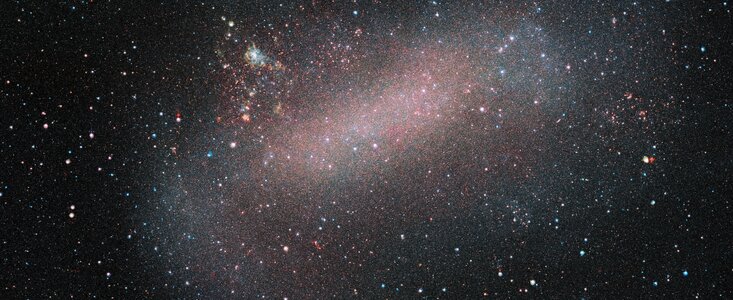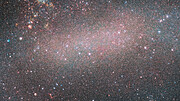Komunikat prasowy
VISTA ukazuje nowe zdjęcie Wielkiego Obłoku Magellana
13 września 2019
Należący do ESO teleskop VISTA ukazał niezwykły obraz Wielkiego Obłoku Magellana, jednej z naszych najbliższych galaktycznych sąsiadek. Teleskop VISTA dokonuje przeglądu tej galaktyki i jej siostry zwanej Małym Obłokiem Magellana, a także ich otoczenia, w niesamowitych szczegółach. Przegląd ten pozwala astronomom na obserwowanie wielkiej liczby gwiazd otwierając nowe możliwości do badania ewolucji gwiazd, dynamiki galaktyk oraz gwiazd zmiennych.
Wielki Obłok Magellana, w skrócie LMC, jest jedną z naszych najbliższych galaktycznych sąsiadek. Znajduje się w odległości zaledwie 163 000 lat świetlnych od Ziemi. Razem z siostrzaną galaktyką zwaną Małym Obłokiem Magellana, należą do najbliższych karłowatych galaktyk satelitarnych w stosunku do Drogi Mlecznej. LMC jest także domem różnych gwiazdowych skupisk i idealnym laboratorium dla astronomów do badania procesów, które kształtują galaktyki.
Należący do ESO teleskop VISTA obserwował obie galaktyki przez ostatnią dekadę. Zaprezentowane dzisiaj zdjęcie jest wynikiem jednego z wielu przeglądów, które astronomowie wykonali przy pomocy teleskopu VISTA. Głównym celem przeglądu VISTA Magellanic Clouds (VMC) Survey było wykonanie mapy historii formowania się gwiazd w Wielkim i Małym Obłoku Magellana, a także trójwymiarowych map ich struktury.
Kluczem do tego zdjęcia był teleskop VISTA, ponieważ obserwuje on niebo w bliskiej podczerwieni. Pozwala to na zerknięcie poprzez obłoki pyłu, które przesłaniają część galaktyki. Obłoki blokują znaczną część światła widzialnego, ale są przezroczyste dla dłuższych fal, do obserwacji których skonstruowano teleskop VISTA. W efekcie wyraźnie widać o wiele więcej gwiazd rozmieszczonych w centrum galaktyki. Astronomowie szczegółowo przeanalizowali około 10 milionów gwiazd w Wielkim Obłoku Magellana i ustalili ich wiek przy pomocy najnowszych modeli [1]. Okazało się, że młode gwiazdy rozmieszczone są w kilku ramionach spiralnych w tej galaktyce.
Od tysiącleci Obłoki Magellana fascynowały ludzi zamieszkujących południową półkulę, ale były nieznane dla Europejczyków aż do Wieku Odkryć. Nazwa, której używamy obecnie, odnosi się do podróżnika Ferdynanda Magellana, który 500 lat temu rozpoczął podróż dookoła Ziemi. Dzienniki z ekspedycji, po ich przewiezieniu do Europy, ujawniły wiele miejsc i rzeczy, które Europejczycy zobaczyli po raz pierwszy. Duch eksploracji i odkryć jest jeszcze bardziej żywy obecnie w pracy astronomów na całym świecie, w tym w zespole przeglądu VMC Survey, którego obserwacje doprowadziły do powstania tego niesamowitego zdjęcia Wielkiego Obłoku Magellana.
Uwagi
[1] Modele gwiazd pozwalają astronomom na przewidywanie życia i śmierci gwiazd, dając wgląd w ich własności, takie jak wiek, masa i temperatura.
Więcej informacji
Gwiazdy ukazane na omawianym zdjęcie zostały przeanalizowane w artykule pt. “The VMC Survey - XXXIV. Morphology of Stellar Populations in the Magellanic Clouds”, który ukaże się w czasopiśmie Monthly Notices of the Royal Astronomical Society.
ESO jest wiodącą międzyrządową organizacją astronomiczną w Europie i najbardziej produktywnym obserwatorium astronomicznym na świecie. Ma 16 krajów członkowskich: Austria, Belgia, Czechy, Dania, Finlandia, Francja, Hiszpania, Irlandia, Holandia, Niemcy, Polska, Portugalia, Szwajcaria, Szwecja, Wielka Brytania oraz Włochy, dodatkowo Chile jest kraje gospodarzem, a Australia strategicznym partnerem. ESO prowadzi ambitne programy dotyczące projektowania, konstrukcji i użytkowania silnych naziemnych instrumentów obserwacyjnych, pozwalając astronomom na dokonywanie znaczących odkryć naukowych. ESO odgrywa wiodącą rolę w promowaniu i organizowaniu współpracy w badaniach astronomicznych. ESO zarządza trzema unikalnymi, światowej klasy obserwatoriami w Chile: La Silla, Paranal i Chajnantor. W Paranal ESO posiada teleskop VLT (Very Large Telescope - Bardzo Duży Teleskop), najbardziej zaawansowane na świecie astronomiczne obserwatorium w świetle widzialnym oraz dwa teleskopy do przeglądów. VISTA pracuje w podczerwieni i jest największym na świecie instrumentem do przeglądów nieba, natomiast VLT Survey Telescope to największy teleskop dedykowany przeglądom nieba wyłącznie w zakresie widzialnym. ESO jest głównym partnerem ALMA, największego istniejącego projektu astronomicznego. Z kolei na Cerro Armazones, niedaleko Paranal, ESO buduje 39-metrowy teleskop ELT (Extremely Large Telescope - Ekstremalnie Wielki Teleskop), który stanie się „największym okiem świata na niebo”.
Linki
Kontakt
Maria-Rosa Cioni
Leibniz-Institut für Astrophysik Potsdam (AIP)
Potsdam, Germany
Tel.: +49 331 7499 651
E-mail: mcioni@aip.de
Mariya Lyubenova
ESO Head of Media Relations
Garching bei München, Germany
Tel.: +49 89 3200 6188
E-mail: pio@eso.org
Krzysztof Czart (Kontakt dla mediów Polska)
Sieć Popularyzacji Nauki ESO
oraz Urania - Postępy Astronomii
Toruń, Polska
Tel.: +48 513 733 282
E-mail: eson-poland@eso.org
O komunikacie
| Komunikat nr: | eso1914pl |
| Nazwa: | Large Magellanic Cloud |
| Typ: | Local Universe : Galaxy : Type : Irregular |
| Facility: | Visible and Infrared Survey Telescope for Astronomy |
| Instrumenty: | VIRCAM |
| Science data: | 2019MNRAS.490.1076E |
Our use of Cookies
We use cookies that are essential for accessing our websites and using our services. We also use cookies to analyse, measure and improve our websites’ performance, to enable content sharing via social media and to display media content hosted on third-party platforms.
ESO Cookies Policy
The European Organisation for Astronomical Research in the Southern Hemisphere (ESO) is the pre-eminent intergovernmental science and technology organisation in astronomy. It carries out an ambitious programme focused on the design, construction and operation of powerful ground-based observing facilities for astronomy.
This Cookies Policy is intended to provide clarity by outlining the cookies used on the ESO public websites, their functions, the options you have for controlling them, and the ways you can contact us for additional details.
What are cookies?
Cookies are small pieces of data stored on your device by websites you visit. They serve various purposes, such as remembering login credentials and preferences and enhance your browsing experience.
Categories of cookies we use
Essential cookies (always active): These cookies are strictly necessary for the proper functioning of our website. Without these cookies, the website cannot operate correctly, and certain services, such as logging in or accessing secure areas, may not be available; because they are essential for the website’s operation, they cannot be disabled.
Functional Cookies: These cookies enhance your browsing experience by enabling additional features and personalization, such as remembering your preferences and settings. While not strictly necessary for the website to function, they improve usability and convenience; these cookies are only placed if you provide your consent.
Analytics cookies: These cookies collect information about how visitors interact with our website, such as which pages are visited most often and how users navigate the site. This data helps us improve website performance, optimize content, and enhance the user experience; these cookies are only placed if you provide your consent. We use the following analytics cookies.
Matomo Cookies:
This website uses Matomo (formerly Piwik), an open source software which enables the statistical analysis of website visits. Matomo uses cookies (text files) which are saved on your computer and which allow us to analyze how you use our website. The website user information generated by the cookies will only be saved on the servers of our IT Department. We use this information to analyze www.eso.org visits and to prepare reports on website activities. These data will not be disclosed to third parties.
On behalf of ESO, Matomo will use this information for the purpose of evaluating your use of the website, compiling reports on website activity and providing other services relating to website activity and internet usage.
Matomo cookies settings:
Additional Third-party cookies on ESO websites: some of our pages display content from external providers, e.g. YouTube.
Such third-party services are outside of ESO control and may, at any time, change their terms of service, use of cookies, etc.
YouTube: Some videos on the ESO website are embedded from ESO’s official YouTube channel. We have enabled YouTube’s privacy-enhanced mode, meaning that no cookies are set unless the user actively clicks on the video to play it. Additionally, in this mode, YouTube does not store any personally identifiable cookie data for embedded video playbacks. For more details, please refer to YouTube’s embedding videos information page.
Cookies can also be classified based on the following elements.
Regarding the domain, there are:
- First-party cookies, set by the website you are currently visiting. They are stored by the same domain that you are browsing and are used to enhance your experience on that site;
- Third-party cookies, set by a domain other than the one you are currently visiting.
As for their duration, cookies can be:
- Browser-session cookies, which are deleted when the user closes the browser;
- Stored cookies, which stay on the user's device for a predetermined period of time.
How to manage cookies
Cookie settings: You can modify your cookie choices for the ESO webpages at any time by clicking on the link Cookie settings at the bottom of any page.
In your browser: If you wish to delete cookies or instruct your browser to delete or block cookies by default, please visit the help pages of your browser:
Please be aware that if you delete or decline cookies, certain functionalities of our website may be not be available and your browsing experience may be affected.
You can set most browsers to prevent any cookies being placed on your device, but you may then have to manually adjust some preferences every time you visit a site/page. And some services and functionalities may not work properly at all (e.g. profile logging-in, shop check out).
Updates to the ESO Cookies Policy
The ESO Cookies Policy may be subject to future updates, which will be made available on this page.
Additional information
For any queries related to cookies, please contact: pdprATesoDOTorg.
As ESO public webpages are managed by our Department of Communication, your questions will be dealt with the support of the said Department.








